This was published 5 years ago
Barcelona, Spain: Architecture tour takes you beyond Gaudi
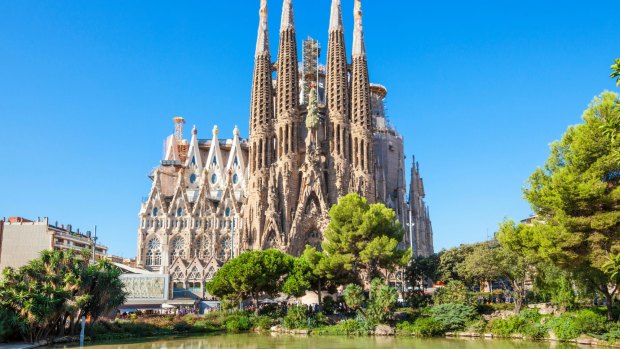
La Sagrada Familia, by Antoni Gaudi, Barcelona, Spain.Credit: Alamy
When you think about architecture in Barcelona, it's natural for Antoni Gaudi to spring to mind. His wildly imaginative buildings adorn virtually every holiday brochure and tour itinerary, and like the millions who flock to the Catalan capital each year, you might well have gazed at the eccentric neo-Gothic spires of his unfinished masterpiece, La Sagrada Familia; wandered past the dreamy rooftop chimneys of his Casa Mila (La Pedrera), or gawped at the kaleidoscopic mosaics of Parc Guell, a hill-top retreat where he honed his landscape gardening skills. Yet Gaudi's creative wonders are just the icing on the cake of a city that wows architecture lovers, full-stop.
Few other places boast such a chocolate-box selection of stunning buildings and al fresco installations. You can easily spend a day neighbourhood-hopping, admiring and photographing visually-arresting architecture - from the medieval landmarks of the Gothic Quarter to the cutting-edge newcomers of Poblenou's 22@ district - and pausing every now and then, perhaps, for a cafe con leche at a pavement cafe or a refreshing glass of cava and tapas at a vivacious bar.
There are intriguing self-guided architecture trails to follow, such as the Ruta del Modernisme, which links 120 of Barcelona's decorative Art Nouveau and Modernist buildings conjured by the likes of Gaudi, Josep Maria Jujol and Lluis Domenech i Montaner in the late 19th and early 20th centuries. But to deepen your appreciation of the city's aesthetic beauty, join a tour with Barcelona Architecture Walks. Comprised of a group of architects hailing from both Catalonia and overseas, it runs a series of themed urban tours, including one wholly devoted to Gaudi's genius.
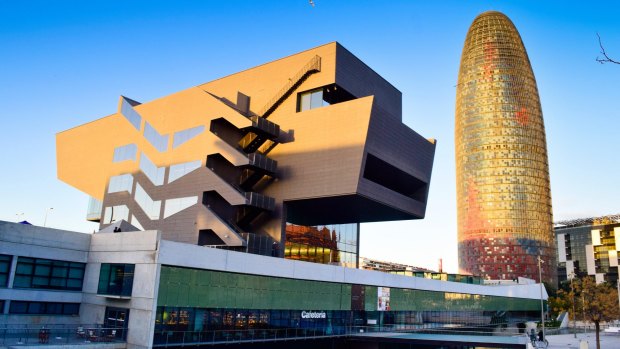
Design Hub Barcelona, DHUB, made by MBM Arquitectes.Credit: Alamy
I'm in Barcelona before embarking on a Mediterranean cruise with Royal Caribbean, and I opt for the Barcelona & Urbanism tour, which explores how today's vibrant metropolis came about and continues to evolve, fashioned by the forces of art, history, politics, economics and nature. On a warm, sun-kissed late afternoon, on Placa Universitat, just north of the city's labyrinthine Gothic core, we meet our bearded guide, Ricard Pons i Mascases. Barcelona-born-and-bred, he's a big Bob Dylan fan, his favourite motto being Dylan's quote: "Nothing is as stable as change". Ricard explains: "I like that because I think it applies to many things, such as the way a city somehow seems to be a finished object, but is actually changing all the time.
Barcelona - as with most cities - is like a living being with its own character. It's a bit like a tree. You don't notice it changing from day to day, but it does." As Dylan's The Times They Are A Changin' starts running through my head - nudging out Freddie Mercury and Montserrat Caballe's operatic Barcelona - we stroll through Eixample, an elegant neighbourhood that sounds far more exotic in Spanish than English (it translates to Expansion). While Eixample is famed for its eye-catching Modernist buildings, it's an under-appreciated architectural jewel in its own right - the brainchild of visionary 19th-century designer, Ildefons Cerda.
As we amble beside Eixample's wide, geometric tree-lined streets and even wider avenues, flanked by imposing apartments, with flowers, laundry and red-and-yellow Catalonia flags fluttering from iron balconies, Ricard brings the potentially dry topic of urban planning to life, pointing out the intricacies of various noteworthy buildings and regaling the absorbing story of Cerda, a civil engineer who was passionate about turning Barcelona into a genuinely "liveable city" (a radical proposal in his day). The Spanish government asked Cerda to expand Barcelona beyond its walled old quarter, which dated back to Roman times and saw a huge population increase during the industrial revolution. By the mid-1850s, as factories and homes sat cheek-by-jowl, overcrowding and diseases, such as tuberculosis and cholera, were rampant. But after the walls came down, on Cerda's recommendation, Barcelona could breathe, and Eixample spread, gradually connecting the historic quarter with the old villages outside the city limits (including Gracia, now one of Barcelona's most desirable districts).
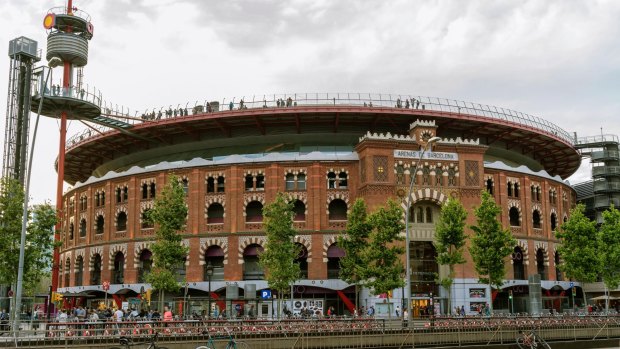
Former bullring, Arenas de Barcelona.Credit: Alamy
Ricard shows us photographs of Cerda's masterplan, which was to be seven times larger than the old quarter and mashed many urban planning influences: from ancient Greece and Rome, the colonial towns of the Spanish Americas, and Baron Haussmann's contemporaneous boulevard-filled renovation of Paris. Today, Eixample's wide arteries buzz with tooting cars, buses, scooters and bicycles but were built to allow easy passage for transport such as horse-drawn carriages and railways (Cerda was fascinated by these new-fangled trains). Roomy sidewalks slowly bloomed for pedestrians, and with more space to play with, Barcelona's affluent families, merchants and municipal authorities commissioned architects to construct ostentatious homes and offices.
On Gran Via, one of Eixample's main thoroughfares, we pause outside La Casa de la Lactancia, which was originally built to support children from disadvantaged families. Bearing a sculpture on its facade of women breastfeeding, it's now an elderly people's home, capped by a sleek glassy annex.
The well-being of residents, rich or poor, was key to Cerda's plan, says Ricard, and while many ideas were implemented, some of of his socially-minded proposals were watered down under pressure from property speculators and landowners. Cerda wanted low-density buildings, no more than three storeys high, to enhance natural light and ventilation, with each block to have inner communal green spaces, too. But restrictions were eased, buildings soared up to seven and eight levels, and factories and apartments mushroomed where gardens were supposed to be. Angry at how his project had been compromised, Cerda fled Barcelona, and died in poverty in northern Spain, reportedly never having been paid for his Eixample exploits.
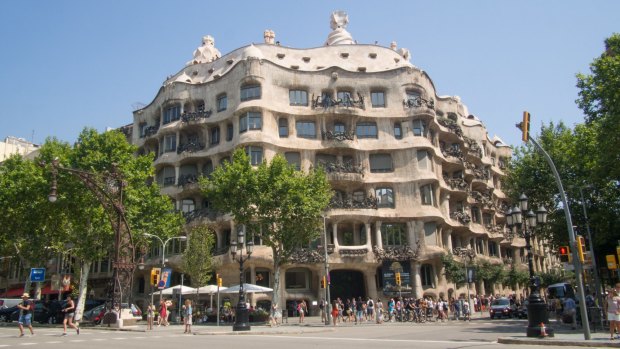
Antoni Gaudi's Casa Mila better known as La Pedrera, built with a limestone facade.Credit: Alamy
Some of the wrongs of the past are being fixed, says Ricard, who leads us into a cluster of inner apartment courtyards where community hubs have flourished over one-time industrial sites. Behind the shiny contemporary Sant Antoni library, where the brick chimney of a former sweets factory still stands, kids lark around on climbing frames and kick footballs, as their parents chat and mingle (or tap into the free wifi). Ricard says more and more apartment rooftops now have gardens, a trend that would no doubt have pleased Cerda.
We end our tour on the lofty viewing platform of CC Arenas de Barcelona, an old bullring given a 21st-century makeover by Sir Richard Rogers (it's perched beside Parc de Joan Miro, a tree- and sculpture-studded enclave built on the site of a former slaughterhouse). Gazing over Barcelona, a city sprawled between sea and mountains, we survey the modern high-rises jutting into the skyline, notably Torre Glories, the "Cucumber", a Catalonian twist on London's Gherkin, by Pritzker Prize-winning French architect Jean Nouvel. Illuminated in vivid colours after dark, it overlooks Placa de les Glories Catalanes, which Cerda had envisaged as the centre of the "new" Barcelona, but remained on the fringes, the surrounding area instead spawning textile factories and workshops, and known as the "Catalan Manchester".
Now rebranded as the 22@ district, it's a riot of construction cranes, skyscraping tech hubs, studio-galleries, luxury apartments, sleek trams and innovative sights such as Encants Vells, which houses a 14th-century flea market beneath its glossy mirrored canopy, and the Museu del Disseny de Barcelona, a design museum that reminds me of a Transformer's head. Ricard covers this fast-changing area on foot in another tour, Barcelona and the Future City (and the following morning I nose around this intriguing district myself). Before bidding us adios, our affable guide returns to Cerda's legacy.
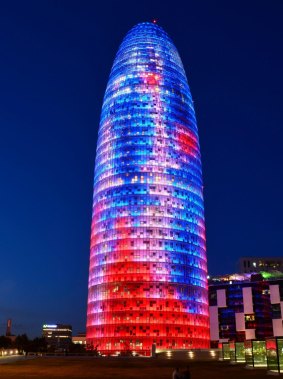
Torre Agbar Agbar Tower, Barcelona, Spain. Credit: age fotostock / Alamy Stock Photo
"Although he was from Catalonia, many saw him as representing the government from Madrid and it took a lot of time for him to be appreciated in Barcelona. But Cerda is part of a chain of miracles that have made Barcelona what is is today. It was his work, his stable grid, that allowed other architects, like Gaudi, to play and create their incredible buildings." Hailing the 1992 Barcelona Olympics as another miracle, the catalyst for the city's transformation into a world-class visitor destination, Ricard adds: "Growing up, I never imagined you could compare Barcelona to great tourist cities like Rome, Paris and London. Well you can now."
Steve McKenna travelled as a guest of Royal Caribbean, Barcelona Architecture Walks and Hotel Arts Barcelona.
TRIP NOTES
MORE
TOUR
Barcelona Architecture Tours run daily public walks, lasting two to three hours and priced from €35 Euro ($55) per person. Private tours can also be booked. See barcelonarchitecturewalks.com
CRUISE
Royal Caribbean operates several cruises from Barcelona, including on its brand new Symphony of the Seas - the world's largest cruise ship. See royalcaribbean.com.au
STAY
For a five-star stay with Mediterranean and city vistas, check into the glass-and-steel Hotel Arts, Barcelona's joint-tallest building (with neighbouring 44-floor Torre Mapfre). The seafront hotel boasts 483 rooms and upmarket bars and eateries (including a two-Michelin-star restaurant and a stylish Club Lounge). You can enjoy breakfast and also hang out in the hotel's lush, pool-blessed gardens, in the shadow of El Peix, Frank Gehry's iconic golden fish sculpture, a symbol of post-Olympics Barcelona. Rooms are priced from 289 Euro ($462). See hotelartsbarcelona.com/en
Sign up for the Traveller Deals newsletter
Get exclusive travel deals delivered straight to your inbox. Sign up now.